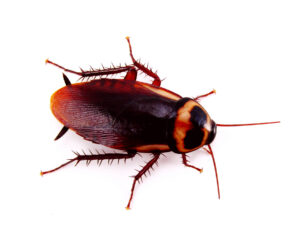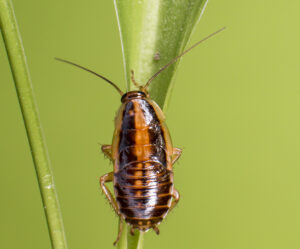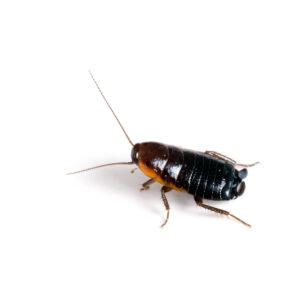Ready to Get Rid of Cockroaches? Here’s How!
Cockroaches are one of the most disliked pests we deal with on a regular basis. While clients are generally desperate to get rid of pests like rodents, termites, and ticks, they’re much more eager to get cockroaches out of their home as quickly as possible! Here in the South, cockroaches are also referred to as Palmetto Bugs. Like their nickname, these pests are unique and unlike any other insect. While most insects serve a purpose, the cockroaches we find around here are some of the only pests that are just that — a pest. In this post, we’re introducing you to the infamous cockroach. We’ll explain the signs of cockroach infestations, how you can prevent them from coming into your home, and how we here at Killingsworth can help you get rid of cockroaches for good.
Meet the Cockroaches of the Carolinas
Across the globe, there are thousands of cockroach species in existence. Around 30 of them are considered “bad” and serve little to no beneficial purpose. Specifically, these include the American, German, Oriental and Brown-Banded cockroaches. Here in the Carolinas, we commonly see all four of these varieties of cockroaches — lucky us!
American cockroach
 The largest and most common variety found in the US is the American cockroach. These are the types often referred to as the nicer-sounding Palmetto bug. With six legs and a reddish-brown colored body, their size ranges from roughly one to two inches in length. Cockroaches are attracted to moist and warm environments. They are typically found inside of homes within the sewers and drains, as well as nesting under appliances and behind kitchen cabinets. They can also be found hiding outdoors underneath mulch and flower beds. Food-wise, they’re attracted to decaying leaves, smaller insects, fungi, algae, food crumbs, and pet food. What’s worse, they can survive extreme conditions. So even though these food resources aren’t readily available, they can always make do. Interestingly, American cockroaches can actually live up to one week without their head!
The largest and most common variety found in the US is the American cockroach. These are the types often referred to as the nicer-sounding Palmetto bug. With six legs and a reddish-brown colored body, their size ranges from roughly one to two inches in length. Cockroaches are attracted to moist and warm environments. They are typically found inside of homes within the sewers and drains, as well as nesting under appliances and behind kitchen cabinets. They can also be found hiding outdoors underneath mulch and flower beds. Food-wise, they’re attracted to decaying leaves, smaller insects, fungi, algae, food crumbs, and pet food. What’s worse, they can survive extreme conditions. So even though these food resources aren’t readily available, they can always make do. Interestingly, American cockroaches can actually live up to one week without their head!
German cockroach
 Unlike the American cockroach, the German cockroach is the most common species found throughout the rest of the world. The German variety also tends to live in residential areas at a higher rate than any other cockroach species. This could be a coincidence, or the simple fact that they’re very popular and literally everywhere! Their color varies from a light brown to dark tan, and they sometimes have stripes running parallel to the length of their body. In addition, these cockroaches are fairly small and generally stay under just one inch in length. Their diet is similar to that of their American counterparts. Signs of a German cockroach infestation are more obvious to spot with this variety. To find them, look around your kitchen and bathroom area for their droppings which resemble small, dark spots or smears — not to be confused with the signs of bed bugs! It’s also known that they leave behind a musty odor that is very distinct to the trained nose. Believe it or not, our pest technicians can sometimes confirm a German cockroach infestation just by smell! Related: What’s That Smell? How to Identify Pest Odors
Unlike the American cockroach, the German cockroach is the most common species found throughout the rest of the world. The German variety also tends to live in residential areas at a higher rate than any other cockroach species. This could be a coincidence, or the simple fact that they’re very popular and literally everywhere! Their color varies from a light brown to dark tan, and they sometimes have stripes running parallel to the length of their body. In addition, these cockroaches are fairly small and generally stay under just one inch in length. Their diet is similar to that of their American counterparts. Signs of a German cockroach infestation are more obvious to spot with this variety. To find them, look around your kitchen and bathroom area for their droppings which resemble small, dark spots or smears — not to be confused with the signs of bed bugs! It’s also known that they leave behind a musty odor that is very distinct to the trained nose. Believe it or not, our pest technicians can sometimes confirm a German cockroach infestation just by smell! Related: What’s That Smell? How to Identify Pest Odors
Oriental cockroach
 The lesser-known Oriental cockroach can be confused as a black beetle. Their bodies are stout, dark black, and smooth. Oriental cockroaches generally grow up to one inch long, with females growing a bit a longer. The males have a set of wings, but are unable to fly. This variety of cockroach also produces a musty odor that can alert people to infestations. Homeowners should look out for Oriental cockroaches in moist gutters, landscaping beds, and sewer drains.
The lesser-known Oriental cockroach can be confused as a black beetle. Their bodies are stout, dark black, and smooth. Oriental cockroaches generally grow up to one inch long, with females growing a bit a longer. The males have a set of wings, but are unable to fly. This variety of cockroach also produces a musty odor that can alert people to infestations. Homeowners should look out for Oriental cockroaches in moist gutters, landscaping beds, and sewer drains.
Brown-Banded cockroach
Last, but not least, is the Brown-Banded cockroach. This invasive species is an issue for many homeowners. Small but mighty, brown-banded roaches come in a variety of light brown shades. They are often confused with German cockroaches due to their similar coloring, but are much smaller in size. Brown-banded cockroaches typically find their way into residential homes inadvertently. They often infest food products, grocery items like bags of potatoes and onions, and furniture in commercial properties and are then brought into your home. What makes them such a pest is the fact that they can eat literally anything. These roaches will eat trash items, several types of fabrics, and so on. Because of their foraging nature, they can easily contaminate your food and pantry items — just one reason why it’s important to know how to get rid of cockroaches.
Illnesses and Disease Spread by Cockroaches
Cockroaches are known to be filthy thanks to their unsanitary nesting and feeding behaviors. Because of this, they can spread several types of bacteria, viruses, parasites, and other pathogens. These are the following infections cockroaches carry and have been known to spread to humans:
Salmonellosis – foodborne bacterial illness
Typhoid Fever – life-threatening bacterial disease
Cholera – gastrointestinal bacterial disease
Dysentery – intestinal infection
Gastroenteritis – stomach flu
Plague – bacterial infection
Leprosy – chronic bacterial infection
Listeriosis – foodborne bacterial illness
Campylobacteriosis – foodborne bacterial illness
Giardia – diarrheal disease
Streptococcus – bacterial infection
Staphylococcus aureus (MRSA) – bacterial infection
Along with these illnesses, cockroaches can cause a flare up of perennial allergies and asthma in those who are sensitive to certain allergens. A protein found in the saliva, feces, and skin of cockroaches is an allergen that some people are unknowingly sensitive to (until they come in contact with an infestation). According to the World Health Organization, 23 to 60 percent of those who live with asthma are allergic to cockroach allergens! To prevent your allergies from worsening and potential illness, get rid of cockroaches within your home.
Why do Cockroaches Exist?
This is the question you’re likely asking yourself right now. If cockroaches are so gross and useless, why are they even here? As much as we humans despise them, they do act as a food source for several types of small reptiles and mammals. While no animal solely lives on a diet of cockroaches alone, they can at least be used to supplement an animal’s diet. Plus, these pests are decomposers and help break down organic materials through digestion. Cockroach feces — while bad for humans — is food for the ecosystem. Their feces deposit nitrogen back into the soil, a critical role of the nitrogen cycle which provides critical nutrients for all living organisms. So, while cockroaches are mainly a filthy pest that can possibly make us ill, they technically do help the earth out a little bit. However, that does not mean you should allow them to enter your home! In this scenario (and every scenario), the bad heavily outweighs the good.
Signs of Cockroach Infestation
Cockroach droppings, egg capsules, and odor that we’ve mentioned are the most obvious way to spot this pest. Otherwise, keep a look out for the actual pest in its various life cycle forms to get rid of cockroaches of all life stages. A sign of cockroach infestations is the presence of dark-colored egg capsules. The female carries around her egg case until she finds a suitable place to place it until the larvae are ready to hatch. These capsules hold roughly 16 eggs and work similar to an incubator. You can usually find these capsules underneath furniture or the crevices in between appliances.
How to Prevent Cockroaches
Preventing these pests is the key to never having to see or deal with them!
Clean Your Home
The most important factor is to keep your house spotless. Cockroaches are attracted to any and all food particles that are left behind. Trash, open food items, grease build-up, etc. are attractants that basically invite cockroaches into your home. Immediately wiping up all spills, crumbs, leftover food, and dirty dishes will help prevent cockroach infestations from taking over your home. This starves them, thus resulting in the roaches dying or moving elsewhere in search of new food resources.
Stay Dry
As we now know that cockroaches love moist areas, you must keep your home dry. This task can be difficult when you live somewhere like the South where it’s fairly humid throughout the year. But this is crucial for maintaining a cockroach-free home. Always stay on top of fixing leaks, removing standing water, and cleaning drains. A dry environment is not conducive to keeping cockroaches satisfied long enough to stick around.
Seal Entry Points
Finally, make sure there are absolutely no entry points in your home where cockroaches can easily find their way inside. Just like most pests, cockroaches are in search of food and shelter to protect themselves from the elements and to lay eggs. Additionally, get rid of any clutter inside and outside of your home. Debris and wood piles are attractive to not only cockroaches, but wood-boring insects as well. Take the time to seal any cracks or gaps that a cockroach can squeeze into when searching for food or shelter. Together, these three practices can prevent cockroach infestations within your home.
How to Get Rid of Cockroaches the Killingsworth Way
Keep in mind that cockroaches are hard to kill, and you must know how to do it effectively. While spraying commercial pesticides might help in the short term, this not only heightens the chance of completely missing the pest, but it’s also harmful to your health. Instead, cockroaches must be flushed out in phases, which is something most homeowners don’t realize. As you can see, it’s not a one and done deal when trying to get rid of cockroaches. Getting rid of cockroaches is a process that requires knowledge of cockroach behavior, understanding where they hide and nest, and knowing what they’re attracted to. When getting rid of any pest, we make sure we are eliminating the resources that are causing the infestation. This way, we know we are truly eliminating the pest — rather than forcing them to retreat into their hiding corners. And because we know where those corners are, we can remove them from your home entirely! For a better way of getting rid of cockroach infestations, choose us to eliminate these pests for you. We can ensure your cockroaches will be gone for good! To schedule your service, click the button below.